When it comes to high level of humidity indoors (bathroom, restroom, kitchen), the portion of the floor covering is a tile is. This is due to the presence of appropriate characteristics and properties of the material. But with the base under the tile must be carefully prepared and have the properties of smoothness and durability. For this reason, the best option would be a self-leveling floor just under the tiles.
The floor under the tile
When you want to lay tile self-leveling floor It must be carried out qualitatively. For this purpose, different mixtures of, presented in the assortment in stores. They are sufficiently diluted with the required amount of water and fill to implement.
A large amount of water will not give a solution better flowability. conversely, he will lose those properties and qualities, inherent self-leveling floor.
Not everyone knows about, you can put the tile on the floor filler or not. Here at once can draw attention to the final result. 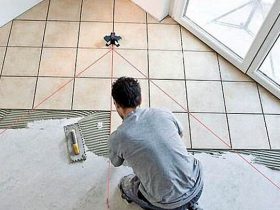 Sex after pouring self-leveling compounds becomes perfectly flat, durable and has a number of positive qualities. Such a foundation is best for tile and other floor coverings.
Sex after pouring self-leveling compounds becomes perfectly flat, durable and has a number of positive qualities. Such a foundation is best for tile and other floor coverings.
This indicates, that self-leveling floor unit is an excellent basis for subsequent tile installation. In addition, due to the flatness of the surface of the material flow (glue) Tile is markedly reduced.
advantages of the floor
Mixes on the basis of a polymer with the time of occurrence started to gain popularity among the artists work. This is due to the fact, that the mixtures have a lot of positive qualities, and he installation process does not require a specific knowledge. They can be used for the device is not only a finishing layer of the floor, but also as a base, to even out any irregularities and make amends for defects. The surface becomes very robust and capable of withstanding numerous load.
If it is a question about a base layer, it is suitable for the subsequent flooring flooring, including the huge popularity and has ceramic tile.
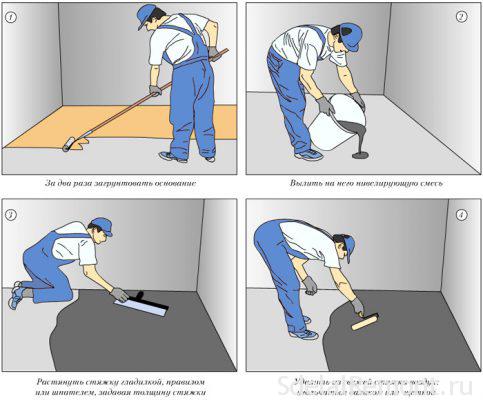
As the base for the device gender It may be not only concrete screed, but the wooden base. In the latter case, do not even need to remove the old board, when there is no mold on them, damages and other defects. Existing joints can cover up a special sealant based on silicone, and also to arrange waterproofing, that water from the final solution is not directed at the beam.
By reducing the time of drying the diluted mixture with water, already in a short time can be carried out on the surface of the tile laying. Usually this time is three days. Several carefully manage costs with laminate or parquet, because then it would be better to wait at least a week after casting. During this time out all the moisture from the solution.
Screed or fill
everyone thinks, that an excellent option base under the tile will be the cement screed. Of course, you can select among the advantages of low cost in the end, and little expensive solution preparation process. a screed process itself does not take much time and effort, while allowing inexperienced professionals participated. Suffice it to have a good tile adhesive, that was attached to this base tile.
But there are downsides screed, which can be called significant. With these few people disagree. minimal thickness is 30 mm. But it immediately to increase the presence of large elevation changes sex. 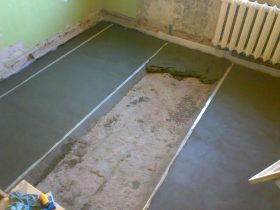 If you make it smaller layer, it can crack with the passage of time, and will not have all the possible strength properties. If the stick is also a tile, the distance from the ceiling will be significantly smaller. Another important drawback - the drying time, which can take up to one month. Terms of carrying out of repair work in any room will be delayed.
If you make it smaller layer, it can crack with the passage of time, and will not have all the possible strength properties. If the stick is also a tile, the distance from the ceiling will be significantly smaller. Another important drawback - the drying time, which can take up to one month. Terms of carrying out of repair work in any room will be delayed.
As for the self-leveling floor, the slightly high price immediately closes all the disadvantages and provides Executive excellent properties and quality. With it, the work will be a joy, and your time is reduced by several times.
self-leveling floor technology
The most common version of the device self-leveling floor - two layers. The first layer may even be called a base. But even in this case it has a negligible thickness with a large number of advantages. It's almost the same screed, but a very thin layer. It is worth noting, that small thickness is achieved due to the addition of the mixture of the modifying substances.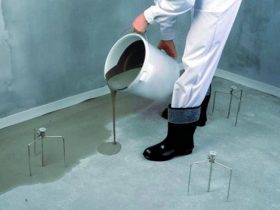
When the casting surface has been prepared at a decent level and in compliance with the device technology, possible to start kneading solution. For him, used a mixture, depending on the requirements of the Executive. Each of them has different properties and qualities. In a separate category are recovered, which are able to withstand high levels of humidity.
The powder is added the required amount of water and thoroughly stirred. It is worth noting, that all the recommendations of the kneading of the solution spelled out on the packaging. The manufacturer recommends to carry out all the way, all qualities were preserved. Then the self-leveling floor will turn out perfectly flat, suitable for laying tiles.
The final solution is poured onto the prepared substrate. It is worth noting, that the installation must be performed from the far corner of the room, where everything and spills. Thereafter fill leveled by the floor area with a spatula or a rule. It is not uncommon use of two-component mixtures, are mixed prior to pouring.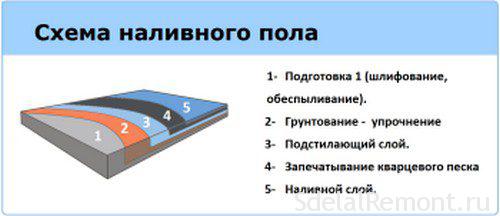
It is important to remove any air bubbles, which could be formed during the screed and in the preparation of the solution. For this purpose the needle roller, which is rolled over the entire area in the room. Complete drying of the mixture after pouring occurs after one day. This may indicate the information on the packaging from the manufacturer.
Self-leveling floor on a tile
Difficult to remove the tiles to the device self-leveling floor. For this reason, the question arises, whether it is possible to fill in on the tile floors. Many need time, to beat off the old coating, and the subsequent need to additionally arrange a tie, to smooth out the bumps formed.
So, whether it is possible to fill in the self-leveling floor tiles? Can, but it should prepare the base and check the tiles on the strength and reliability of fixing. If it fits tightly and is not bulged, be sure to clean it. Some problems arise with glossy tiles. some deem, in that case the adhesion is not practical and the quality of self-leveling floor will remain at a low level. To avoid this, the gloss is removed, then carefully trimmed surface to fill.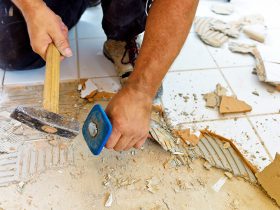
This indicates, it is possible to fill in the self-leveling floor tiles. After this will pour prepared solution and razravnyat it with a spatula. I.e, all carried out in compliance with such floor construction technology.
Self-leveling floor can be poured on the tiles, but it is important to view the entire surface underneath it. If you skip this item, in the subsequent issues will be more serious, of dismantling sex-drenched. That this encounter did not want even the experts, because the process is very time-consuming. Simply pour additional layer, eliminating all errors.
Installation of tiles
When the surface becomes smooth and completely dry, you can begin to lay the tiles. For this purpose, a special two-component adhesive, designed for tile flooring. consumption of glue, which costs quite expensive, reduced by the presence of perfectly flat floor surface.
Self-leveling floor before laying the tiles must be primed. It is applied in several layers over the entire area without gaps. This increases the adhesion level, and tiles grip is much better.
After the installation of the tiles on the tile surface, All seams must be cleaned, and adhesive residues are removed from the surface. 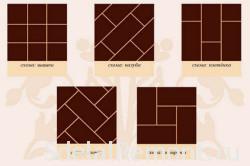 If anyone is interested in the thermal conductivity of the "pie", it should pay attention to the selected tile, since its thickness is greater, layer than the inlet floor.
If anyone is interested in the thermal conductivity of the "pie", it should pay attention to the selected tile, since its thickness is greater, layer than the inlet floor.
In this way, if you pour self-leveling floor for the subsequent laying of tiles in the rooms, the quality of work will be at a high level. In this case, adhesive consumption will be minimal due to a perfectly flat surface.












